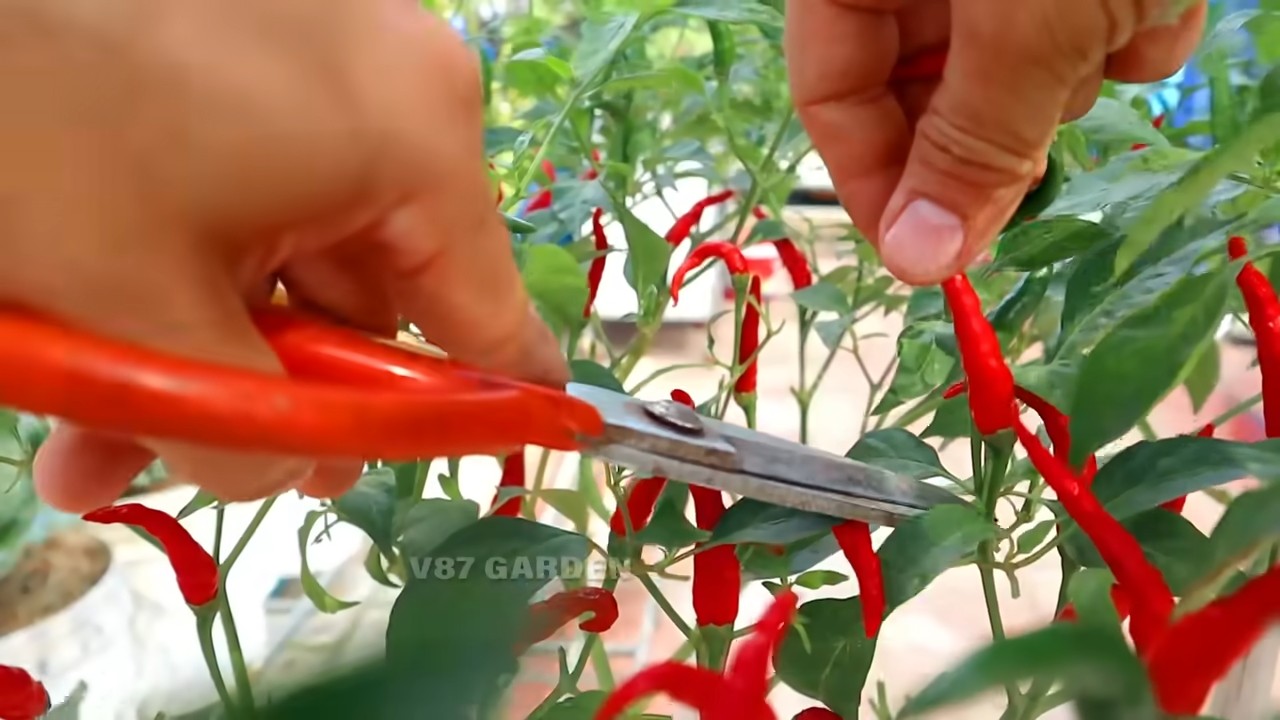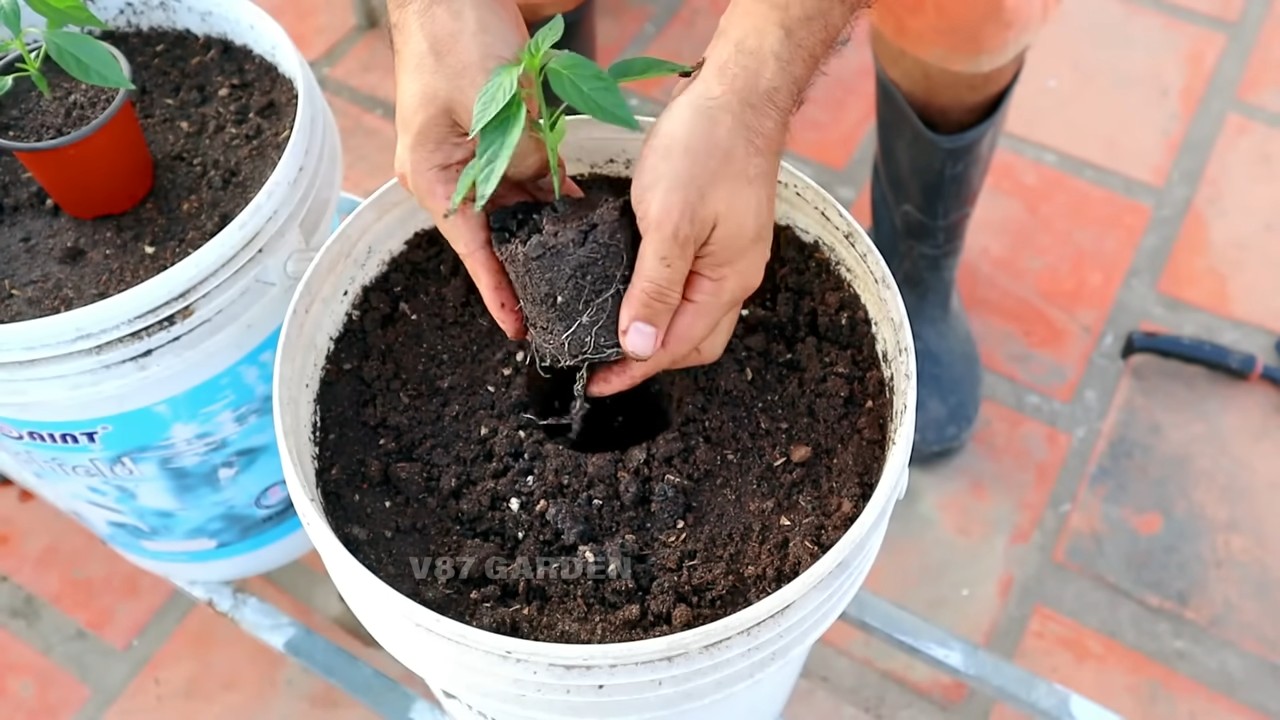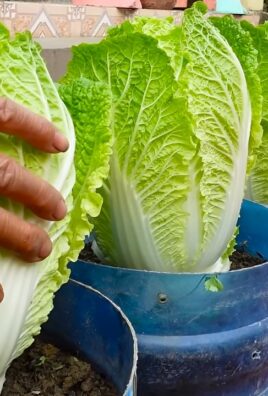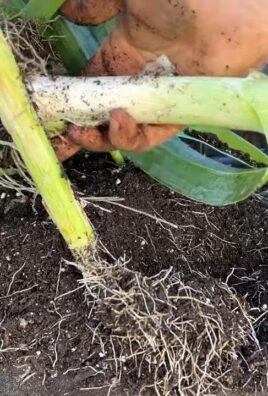Grow Chili Peppers Indoors and spice up your life, literally! Imagine plucking fresh, fiery chili peppers right from your windowsill, adding a vibrant kick to your meals whenever you please. Forget those bland, store-bought peppers 鈥?we’re talking about homegrown flavor explosions, bursting with sunshine and your own personal touch.
For centuries, cultivating peppers has been a global passion. From the ancient civilizations of South America, where chili peppers were revered for their culinary and medicinal properties, to modern-day kitchens around the world, these fiery fruits have held a special place in our hearts (and stomachs!). But what if you don’t have a sprawling garden? That’s where the magic of indoor gardening comes in!
In this DIY guide, I’m going to share my favorite tricks and hacks for successfully grow chili peppers indoors, even if you’re a complete beginner. We’ll cover everything from choosing the right varieties and providing optimal lighting to mastering watering techniques and warding off pesky pests. Why spend money on expensive, often lackluster peppers when you can easily cultivate your own thriving chili pepper plants right in the comfort of your home? Let’s get started and transform your living space into a miniature chili pepper paradise!

Growing Fiery Chili Peppers Indoors: My Spicy DIY Guide
Okay, chili pepper lovers, gather ’round! I’m going to share my secrets for cultivating a thriving chili pepper garden right inside your home. Forget relying on grocery store peppers 鈥?imagine plucking fresh, vibrant chilies whenever you need a kick of heat! It’s easier than you think, and I’m here to guide you every step of the way.
Choosing Your Chili Pepper Varieties
Before we dive into the nitty-gritty, let’s talk about pepper selection. Not all chili peppers are created equal, especially when it comes to indoor growing. Some varieties are naturally more compact and suited for container life. Here are a few of my favorites:
* Thai Chili Peppers: These are prolific producers and relatively small, making them perfect for pots. They pack a serious punch!
* Jalape帽o Peppers: A classic choice! Jalape帽os are easy to grow and offer a moderate level of heat.
* Serrano Peppers: Similar to jalape帽os but with a bit more fire. They also do well in containers.
* Habanero Peppers: If you’re brave, try habaneros! They need a bit more attention but are incredibly rewarding. Be warned, they are HOT!
* Poblano Peppers: Milder than some, poblanos are great for stuffing and roasting. They tend to grow a bit larger, so choose a bigger pot.
Important Tip: Consider the size of your growing space when choosing your varieties. A tiny apartment might not be ideal for a sprawling poblano plant.
Gathering Your Supplies
Now, let’s get our hands dirty (figuratively, for now!). Here’s what you’ll need to get started:
* Chili Pepper Seeds: You can buy seeds online, at garden centers, or even save them from existing peppers (just make sure they’re from a reliable source).
* Seed Starting Tray or Small Pots: These are perfect for germinating your seeds.
* Seed Starting Mix: This is a light, sterile soil mix that’s ideal for delicate seedlings.
* Larger Pots (5-gallon or larger): Once your seedlings are big enough, they’ll need to be transplanted into larger pots.
* Potting Soil: Choose a well-draining potting mix specifically formulated for vegetables.
* Grow Lights: This is crucial for indoor growing, especially if you don’t have a lot of natural sunlight. LED grow lights are energy-efficient and work great.
* Watering Can or Spray Bottle: For gentle watering.
* Fertilizer: A balanced fertilizer formulated for tomatoes or peppers will provide essential nutrients.
* Small Fan: To improve air circulation and prevent fungal diseases.
* Optional: Heat Mat: To speed up germination.
* Optional: Plant Labels: To keep track of your different varieties.
Starting Your Seeds
This is where the magic begins!
1. Prepare Your Seed Starting Tray: Fill your seed starting tray or small pots with seed starting mix. Moisten the mix thoroughly, but don’t soak it.
2. Sow Your Seeds: Plant 2-3 seeds per cell or pot, about 录 inch deep.
3. Cover and Water: Gently cover the seeds with more seed starting mix and water lightly with a spray bottle.
4. Provide Warmth: Chili pepper seeds germinate best in warm conditions (75-85掳F). You can use a heat mat to maintain the ideal temperature.
5. Maintain Moisture: Keep the seed starting mix consistently moist, but not waterlogged. You can cover the tray with a clear plastic dome or plastic wrap to help retain moisture.
6. Be Patient: Germination can take anywhere from 7-21 days, depending on the variety and conditions.
Transplanting Your Seedlings
Once your seedlings have developed their first set of true leaves (the leaves that look like miniature versions of the adult leaves), it’s time to transplant them into larger pots.
1. Prepare Your Larger Pots: Fill your 5-gallon (or larger) pots with potting soil.
2. Gently Remove Seedlings: Carefully remove the seedlings from the seed starting tray or small pots. Be gentle to avoid damaging the roots. I like to use a small spoon to help lift them out.
3. Plant Seedlings: Dig a hole in the potting soil large enough to accommodate the seedling’s root ball. Place the seedling in the hole and gently backfill with soil.
4. Water Thoroughly: Water the newly transplanted seedlings thoroughly.
5. Provide Support (Optional): If your seedlings are leggy or prone to falling over, you can use small stakes or plant supports.
Providing the Right Environment
Chili peppers need specific conditions to thrive indoors. Here’s what to keep in mind:
* Light: Chili peppers need at least 6-8 hours of direct light per day. If you don’t have enough natural sunlight, use grow lights. Position the grow lights a few inches above the plants and adjust them as the plants grow.
* Temperature: Chili peppers prefer warm temperatures (70-85掳F during the day and 60-70掳F at night).
* Humidity: Chili peppers like moderate humidity. You can increase humidity by placing a tray of water near the plants or using a humidifier.
* Air Circulation: Good air circulation is essential to prevent fungal diseases. Use a small fan to circulate the air around your plants.
Watering and Fertilizing
Proper watering and fertilization are crucial for healthy chili pepper plants.
* Watering: Water your chili pepper plants when the top inch of soil feels dry to the touch. Water thoroughly, until water drains out of the bottom of the pot. Avoid overwatering, as this can lead to root rot.
* Fertilizing: Fertilize your chili pepper plants every 2-3 weeks with a balanced fertilizer formulated for tomatoes or peppers. Follow the instructions on the fertilizer label. I like to use a liquid fertilizer diluted to half strength.
Pollinating Your Chili Peppers
Indoor chili peppers often need help with pollination, as there are no bees or other insects to do the job.
1. Hand Pollination: Use a small paintbrush or cotton swab to gently transfer pollen from the stamen (the male part of the flower) to the pistil (the female part of the flower). Do this for each flower.
2. Shake the Plants: Gently shake the plants to help distribute pollen.
3. Use a Fan: The breeze from a fan can also help with pollination.
Dealing with Pests and Diseases
Even indoors, chili pepper plants can be susceptible to pests and diseases.
* Aphids: These tiny insects suck sap from the plants. You can control aphids by spraying them with insecticidal soap or neem oil.
* Spider Mites: These tiny mites create webs on the plants and suck sap. You can control spider mites by spraying them with insecticidal soap or neem oil. Increasing humidity can also help.
* Whiteflies: These small, white insects fly around the plants and suck sap. You can control whiteflies by using sticky traps or spraying them with insecticidal soap.
* Fungal Diseases: Fungal diseases can be prevented by providing good air circulation and avoiding overwatering. If you notice signs of fungal disease, such as powdery mildew or leaf spots, treat the plants with a fungicide.
Harvesting Your Chili Peppers
The most rewarding part!
1. Wait for Ripening: Chili peppers are typically ready to harvest when they reach their mature color (usually red, yellow, or orange, depending on the variety).
2. Use Pruning Shears or Scissors: Cut the peppers from the plant using pruning shears or scissors.
3. Enjoy Your Harvest: Use your fresh chili peppers in your favorite recipes, or dry them for later use.
Troubleshooting Tips
* Yellowing Leaves: This can be caused by overwatering, underwatering, nutrient deficiencies, or pests. Check the soil moisture, fertilize the plants, and inspect for pests.
* Dropping Flowers: This can be caused by temperature fluctuations, lack of pollination, or stress. Maintain consistent temperatures, hand-pollinate the flowers, and avoid stressing the plants.
* Slow Growth: This can be caused by lack of light, nutrient deficiencies, or pests. Provide adequate light, fertilize the plants, and inspect for pests.
Extra Tips for Success
* Rotate Your Plants: Rotate your plants regularly to ensure that all sides receive equal light.
* Prune Your Plants: Pruning can help to improve air circulation and encourage bushier growth.
* Keep Your Plants Clean: Regularly wipe down the leaves of your plants to remove dust and debris.
* Be Patient: Growing chili

Conclusion
So, there you have it! Growing chili peppers indoors is not only achievable, but it can also be a deeply rewarding experience. Forget relying solely on store-bought peppers, often lacking in freshness and sometimes even flavor. By embracing this DIY approach, you gain complete control over the entire process, from seed to table. You’ll be amazed at the vibrant colors, intense aromas, and fiery flavors that your own homegrown chili peppers will bring to your culinary creations.
This isn’t just about saving money; it’s about connecting with your food on a deeper level. It’s about understanding the journey from a tiny seed to a mature, fruit-bearing plant. It’s about the satisfaction of nurturing something with your own hands and reaping the delicious rewards. Plus, let’s be honest, there’s a certain bragging right that comes with saying, “I grew these myself!”
But the best part? The possibilities are endless. Experiment with different varieties of chili peppers, from the mild and fruity poblano to the scorching hot habanero. Try different growing mediums, like coco coir or hydroponics, to see what works best for you. Play around with different lighting setups to maximize your yields. The journey of growing chili peppers indoors is a continuous learning experience, and that’s what makes it so exciting.
Don’t be afraid to experiment! Consider adding companion plants like basil or marigolds to your indoor garden to deter pests and improve the overall health of your chili pepper plants. You can also try different fertilization schedules to find the optimal balance for your plants. Some growers even swear by talking to their plants!
And if you’re feeling adventurous, why not try making your own chili powder or hot sauce with your homegrown peppers? The flavor will be unlike anything you’ve ever tasted. Imagine the look on your friends’ faces when you serve them a dish seasoned with your own homemade chili powder.
We understand that the idea of growing chili peppers indoors might seem daunting at first, but trust us, it’s easier than you think. With a little bit of planning, some basic equipment, and a whole lot of patience, you can be harvesting your own chili peppers in no time.
So, what are you waiting for? Grab some seeds, set up your grow space, and get ready to embark on a flavorful adventure. We encourage you to try this DIY trick and share your experiences with us. Let us know what varieties you’re growing, what challenges you’ve faced, and what successes you’ve achieved. Share your photos, your tips, and your recipes. Let’s create a community of indoor chili pepper growers and inspire others to join the fun.
Remember, the key to success is to start small, be patient, and don’t be afraid to learn from your mistakes. And most importantly, have fun! Growing chili peppers indoors is a rewarding hobby that will bring you years of enjoyment. So, get growing and get ready to spice up your life!
Frequently Asked Questions (FAQ)
What are the best chili pepper varieties to grow indoors?
That’s a great question! While you can technically grow any chili pepper variety indoors, some are better suited for indoor cultivation than others. Compact varieties like Thai peppers, habaneros, jalape帽os, and serranos tend to thrive in smaller spaces. These varieties are generally more manageable and produce a good yield even in limited conditions. However, don’t let that limit you! If you have the space and proper lighting, you can certainly try growing larger varieties like bell peppers or even some of the super-hot peppers like ghost peppers or Carolina reapers. Just be prepared to provide them with adequate support and potentially more intense lighting. Ultimately, the best variety for you will depend on your personal preferences and the space you have available.
How much light do chili peppers need when grown indoors?
Light is crucial for successful indoor chili pepper cultivation. Chili peppers are sun-loving plants and require at least 6-8 hours of direct sunlight per day. If you don’t have a south-facing window that provides enough natural light, you’ll need to supplement with artificial grow lights. LED grow lights are a popular choice because they are energy-efficient and provide a full spectrum of light that is beneficial for plant growth. Fluorescent grow lights are another option, but they are generally less efficient than LEDs. The intensity of the light is also important. You’ll want to choose a grow light that provides enough lumens (a measure of light output) to support healthy growth and fruit production. A good rule of thumb is to aim for at least 2000 lumens per square foot of growing space.
What type of soil is best for growing chili peppers indoors?
The type of soil you use can significantly impact the health and productivity of your chili pepper plants. Chili peppers prefer well-draining soil that is rich in organic matter. A good potting mix will typically contain a blend of peat moss, perlite, and vermiculite. You can also add compost or other organic amendments to improve the soil’s fertility and drainage. Avoid using garden soil, as it can be too heavy and compacted for container gardening. It’s also important to choose a potting mix that is specifically formulated for vegetables or herbs, as these mixes will typically contain the right balance of nutrients for optimal growth.
How often should I water my indoor chili pepper plants?
Watering frequency will depend on several factors, including the size of your pot, the type of soil you’re using, and the temperature and humidity of your growing environment. As a general rule, you should water your chili pepper plants when the top inch of soil feels dry to the touch. Avoid overwatering, as this can lead to root rot. When you do water, water thoroughly until the water drains out of the bottom of the pot. This will ensure that the roots are getting enough moisture. During the hotter months, you may need to water more frequently. You can also use a moisture meter to help you determine when your plants need water.
What are some common pests and diseases that affect indoor chili pepper plants?
Even indoors, chili pepper plants can be susceptible to pests and diseases. Common pests include aphids, spider mites, whiteflies, and fungus gnats. These pests can damage your plants by sucking sap from the leaves or feeding on the roots. To prevent pest infestations, inspect your plants regularly and remove any pests you find. You can also use insecticidal soap or neem oil to control pests. Common diseases that affect chili pepper plants include powdery mildew, fungal leaf spot, and root rot. To prevent diseases, provide good air circulation, avoid overwatering, and use a well-draining potting mix. If you notice any signs of disease, remove the affected leaves or plants immediately.
How do I pollinate my chili pepper plants indoors?
Chili peppers are self-pollinating, meaning they can pollinate themselves. However, indoor plants may need a little help with pollination, as there are no wind or insects to transfer the pollen. You can manually pollinate your chili pepper plants by gently shaking the plants or using a small paintbrush to transfer pollen from one flower to another. You can also use a fan to create a gentle breeze that will help to distribute the pollen. Pollination is essential for fruit production, so make sure to pollinate your plants regularly.
When can I harvest my chili peppers?
The time it takes for chili peppers to mature will depend on the variety. Some varieties, like jalape帽os, can be harvested in as little as 60 days, while others, like habaneros, can take up to 100 days or more. The best way to tell if your chili peppers are ready to harvest is to check their color and size. The peppers should be fully colored and firm to the touch. You can also gently squeeze the peppers to see if they are ready to harvest. If they feel soft or mushy, they are probably overripe. To harvest your chili peppers, simply cut them off the plant with a pair of scissors or pruning shears.
Can I grow chili peppers indoors year-round?
Absolutely! One of the biggest advantages of growing chili peppers indoors is that you can grow them year-round, regardless of the weather outside. With proper lighting, temperature control, and watering, you can enjoy a continuous harvest of fresh chili peppers. This is especially beneficial for those who live in colder climates where outdoor growing is only possible during the summer months.




Leave a Comment